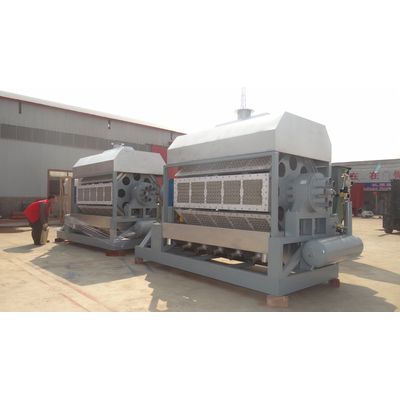

- Home
- Companies
- Beston Group Co., Ltd.
- Articles
- How to Improve Production Efficiency in ...

How to Improve Production Efficiency in an Egg Tray Forming Machine
Maximizing the efficiency of an egg tray forming machine is essential for reducing operational costs and increasing output without compromising product quality. Several factors influence the overall performance, including raw material preparation, process optimization, and equipment maintenance. Implementing strategic improvements can enhance production speed, minimize material waste, and extend machine longevity.
Optimizing Pulp Preparation
The quality of the pulp mixture directly affects the molding process. To ensure consistency, raw materials must be adequately processed before entering the egg tray forming machine. Using a high-performance hydrapulper ensures uniform fiber dispersion, preventing clumping that could lead to uneven tray formation.
Additionally, maintaining an optimal water-to-fiber ratio is crucial. Excess water content prolongs drying time, increasing energy consumption, while insufficient water affects mold filling. Integrating automated pulp consistency monitoring can help regulate slurry composition in real time, improving molding precision.
Enhancing Mold Performance
Mold design and maintenance play a pivotal role in optimizing efficiency. Precision-engineered molds with smooth surfaces facilitate quicker pulp adhesion and water drainage, reducing cycle time. Using high-grade aluminum alloy molds improves durability and ensures dimensional accuracy, minimizing defects.
Routine mold cleaning prevents fiber buildup that can disrupt tray formation. Automated mold-cleaning systems, such as high-pressure air or water jets, streamline this process, reducing downtime. For enhanced efficiency, quick-change mold systems enable rapid switching between different tray configurations without extensive reconfiguration.
Improving Drying Efficiency
The drying phase consumes the most energy in a pulp moulding machine operation. Optimizing this process can significantly impact overall productivity. Utilizing high-efficiency drying tunnels with controlled airflow ensures uniform moisture removal.
Infrared and microwave-assisted drying technologies further accelerate moisture evaporation, shortening drying cycles while conserving energy. For large-scale production, heat recovery systems capture and repurpose excess thermal energy, reducing operational costs and improving environmental sustainability.
Automating Key Processes
Automation minimizes human error and enhances precision in egg tray production. PLC-controlled systems regulate pulp feeding, mold pressing, and drying parameters to maintain consistency across batches. Advanced servo-driven mechanisms improve synchronization between different stages, reducing idle time between cycles.
Integrating robotic stacking and packaging systems streamlines post-production handling, eliminating bottlenecks and increasing throughput. Smart sensors provide real-time diagnostics, alerting operators to mechanical inefficiencies before they escalate into major issues.
Regular Maintenance and Equipment Calibration
Preventive maintenance ensures uninterrupted operation and extends the lifespan of an egg tray forming machine. Routine lubrication of moving components reduces friction and prevents premature wear. Scheduled inspections of vacuum pumps, forming molds, and hydraulic systems help detect early signs of malfunction.
Calibrating forming pressure and vacuum suction settings optimizes pulp deposition, reducing material wastage and improving tray uniformity. Implementing predictive maintenance strategies using IoT-enabled sensors allows for data-driven decision-making, minimizing unplanned downtime.
Conclusion
Improving the efficiency of an egg tray forming machine requires a combination of process optimization, automation, and proactive maintenance. By refining pulp preparation, enhancing mold performance, optimizing drying methods, and leveraging smart technologies, manufacturers can achieve higher productivity with lower resource consumption. As demand for sustainable packaging solutions grows, continuous improvements in egg tray production will remain critical for maintaining a competitive edge.
